ANGLES
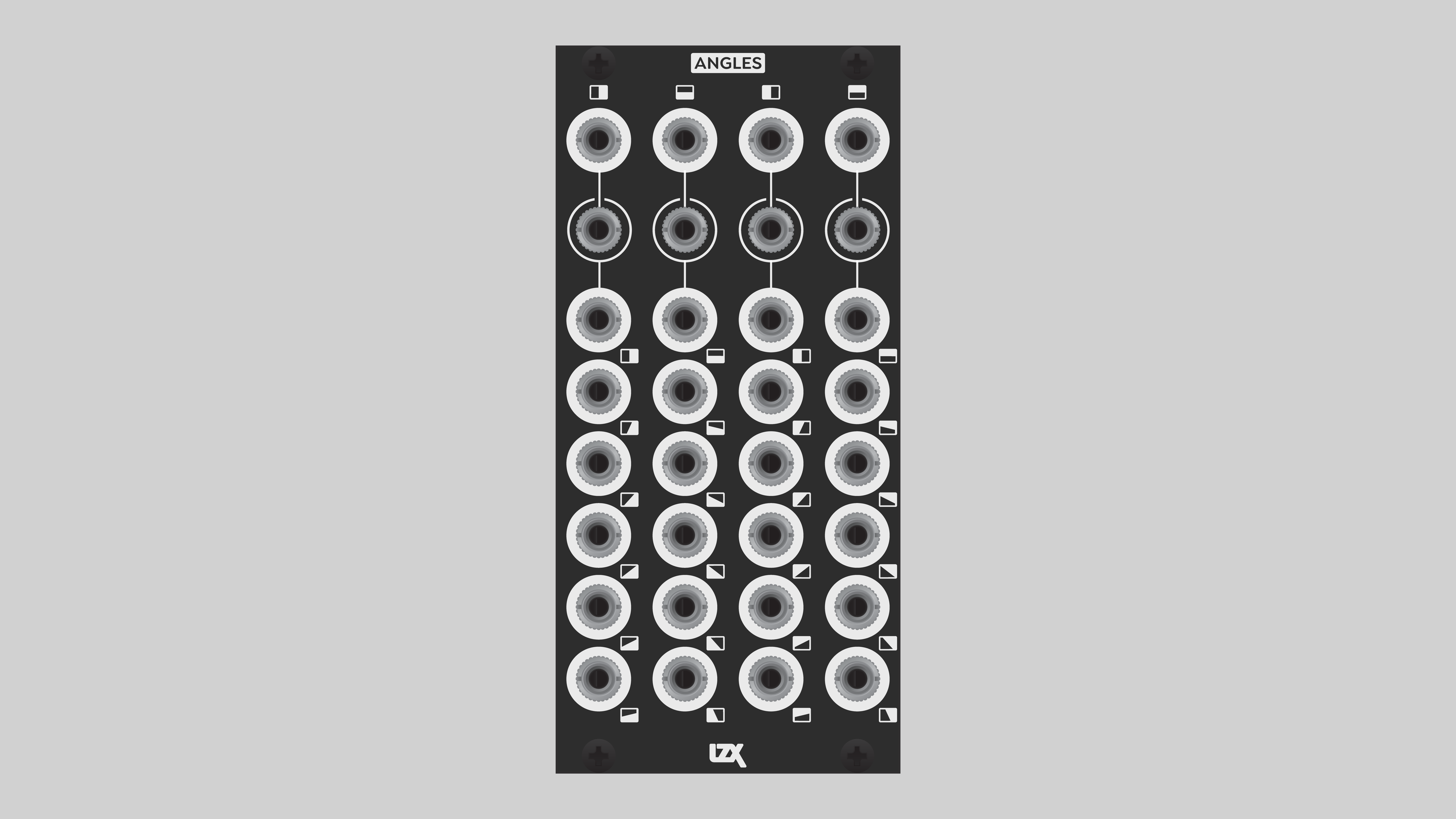
Overview
ANGLES is a dual horizontal and vertical ramp generator and 24-output fixed ratio mixer. That may not sound very exciting at first, but ANGLES is the key to a full range of dynamic compositions in video synthesis.
Horizontal and vertical waveforms are essential ingredients in most generative patches. But with standard H and V ramps and oscillators, patches can feel constrained within a box. Shapes and patterns are oriented parallel or perpendicular to the video frame. Compositions are visually static even when they're animated, because all geometry is based on right angle relationships. That's fine if you want the feeling of the patch to be solid and constant. However, for lively, dynamic compositions, we need geometries oriented along diagonals.
Synthesizing complex geometries, such as vanishing points or polygons, requires diagonally oriented ramps. ANGLES accomplishes this by mixing H and V ramps in fixed proportions. It lets your patch break out of the box with 24 individual ramps rotated in 15-degree increments. Instead of being limited to 0 and 90 degrees, you can now pick any two angles. 24 options for each of the two paired ramps gives over 500 creative alternatives to the ordinary HV ramp combo.
Key Specifications
| Mounting Width | 12 HP |
| Power Consumption | 12V @ 175 mA |
| Power Connectors | 10 pin EuroRack ribbon, 2.1mm DC barrel |
| Included | DC barrel power cable, EuroRack power cable, RCA sync cable |
| Video Sync | Rear RCA in & out |
System Integration Advice
Angles is a great support module to add to a system including one or more of the following: DSG3, DWO3, Stairs, and Keychain. It really shines in systems where its outputs can be distributed throughout the patch to multiple destinations.
Connectors & Indicators
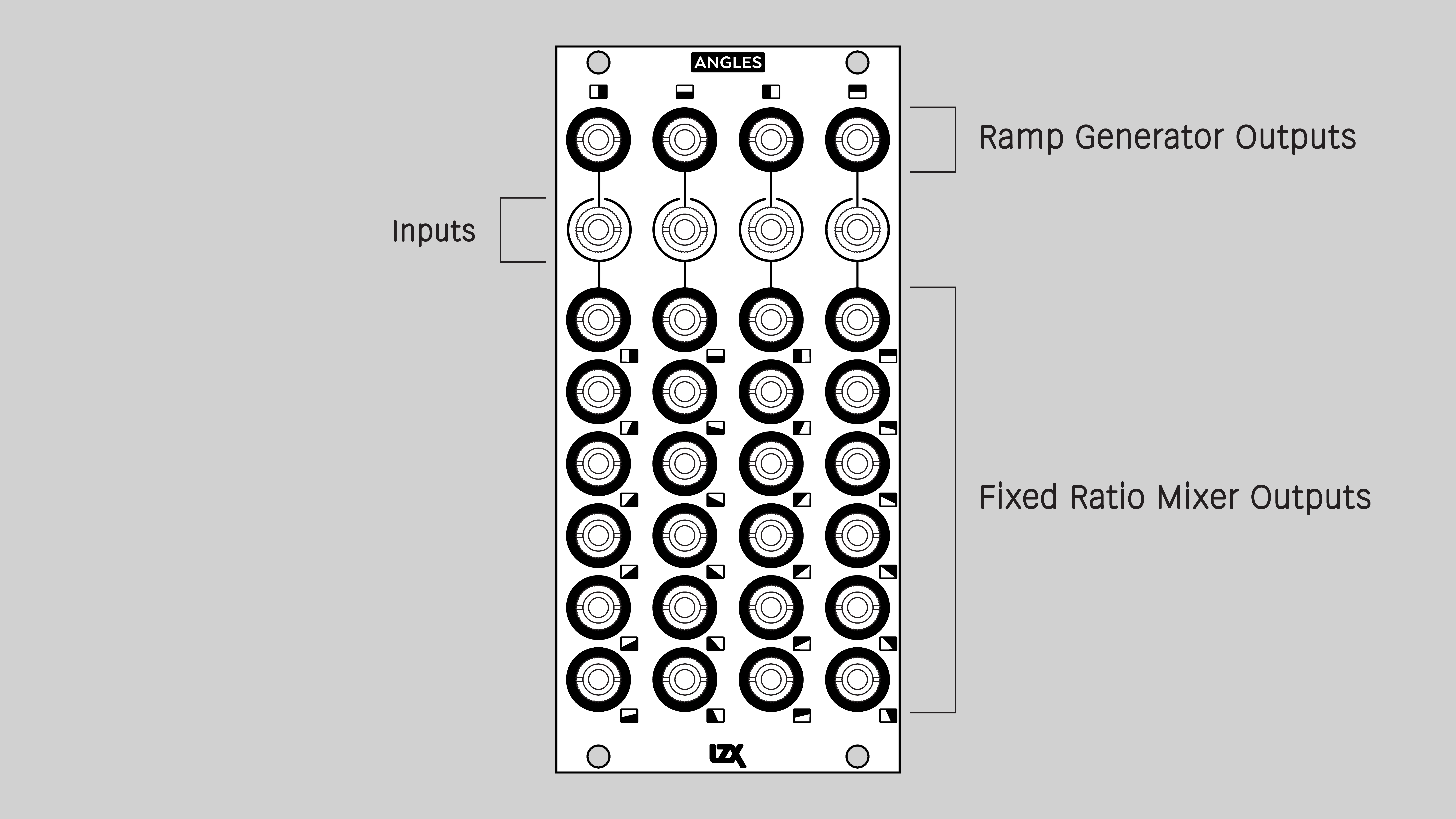
Angles is populated with 32 jacks. The top row of jacks are ramp outputs: horizontal, vertical, inverted horizontal, and inverted vertical.
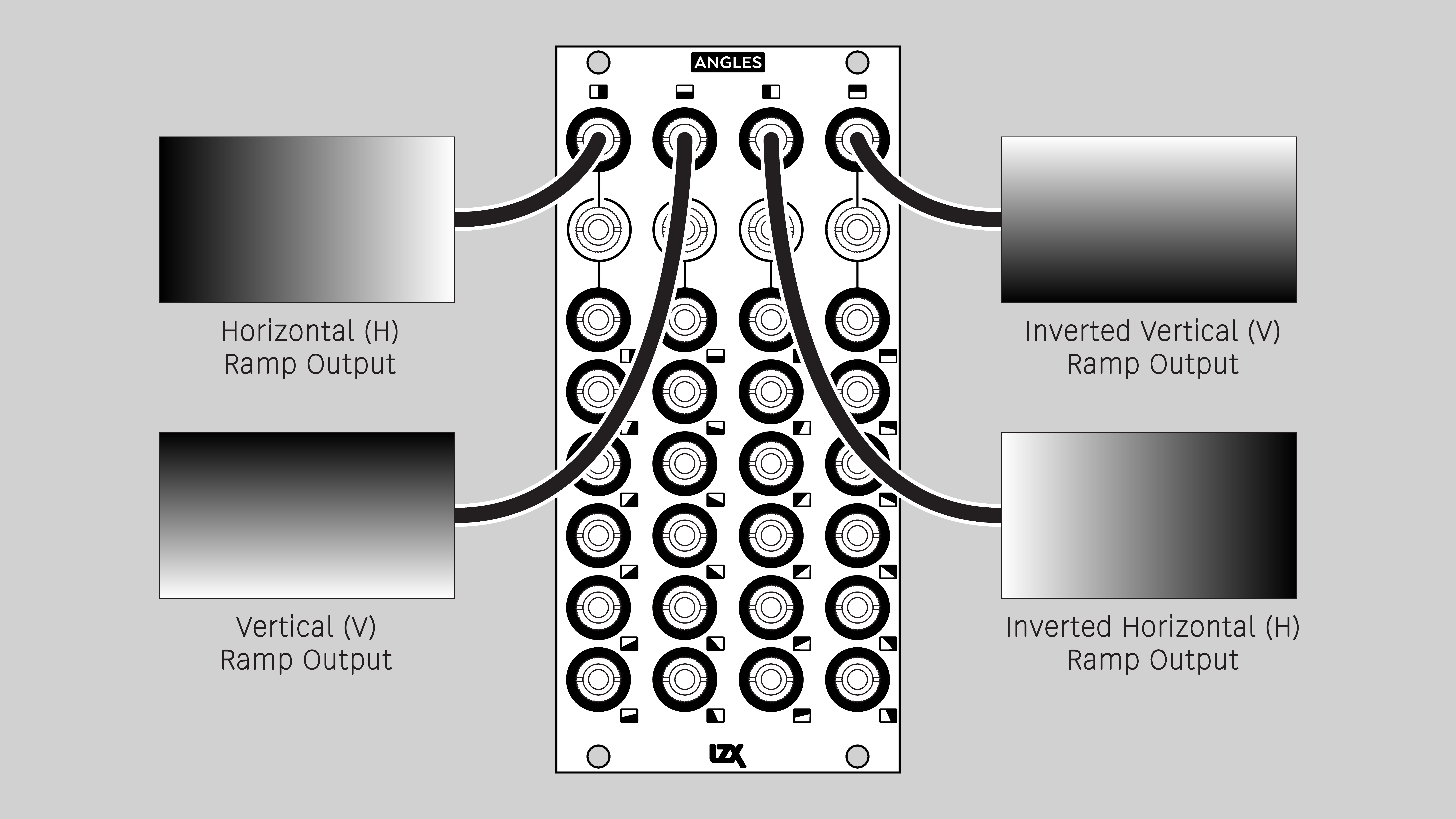
These ramps are internally normalled into the A, B, C, and D input jacks on the second row. If nothing is patched into an input jack, a ramp provides the source to the mixing stages below.
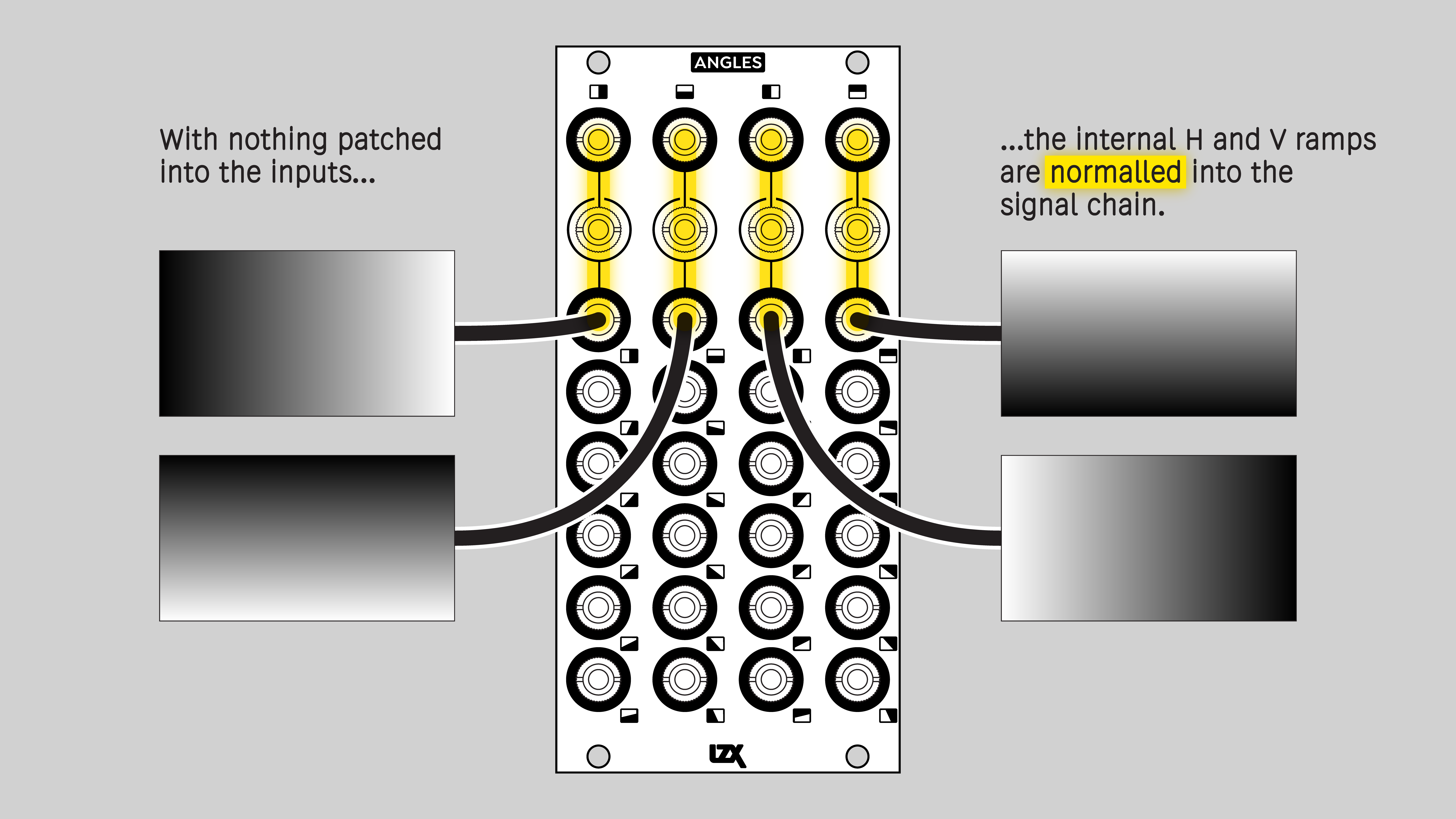
Operation
Each of the 24 outputs is a unique mix of two of the A, B, C, and D inputs. Pairs of sources are mixed at ratios of 1:0, 5:1, 2:1, 1:1, 1:2, and 1:5. This results in mixtures of:
- 100% & 0%
- 83.3% & 16.7%
- 66.7% & 33.3%
- 50% & 50%
- 33.3% & 66.7%
- 16.7% & 83.3%
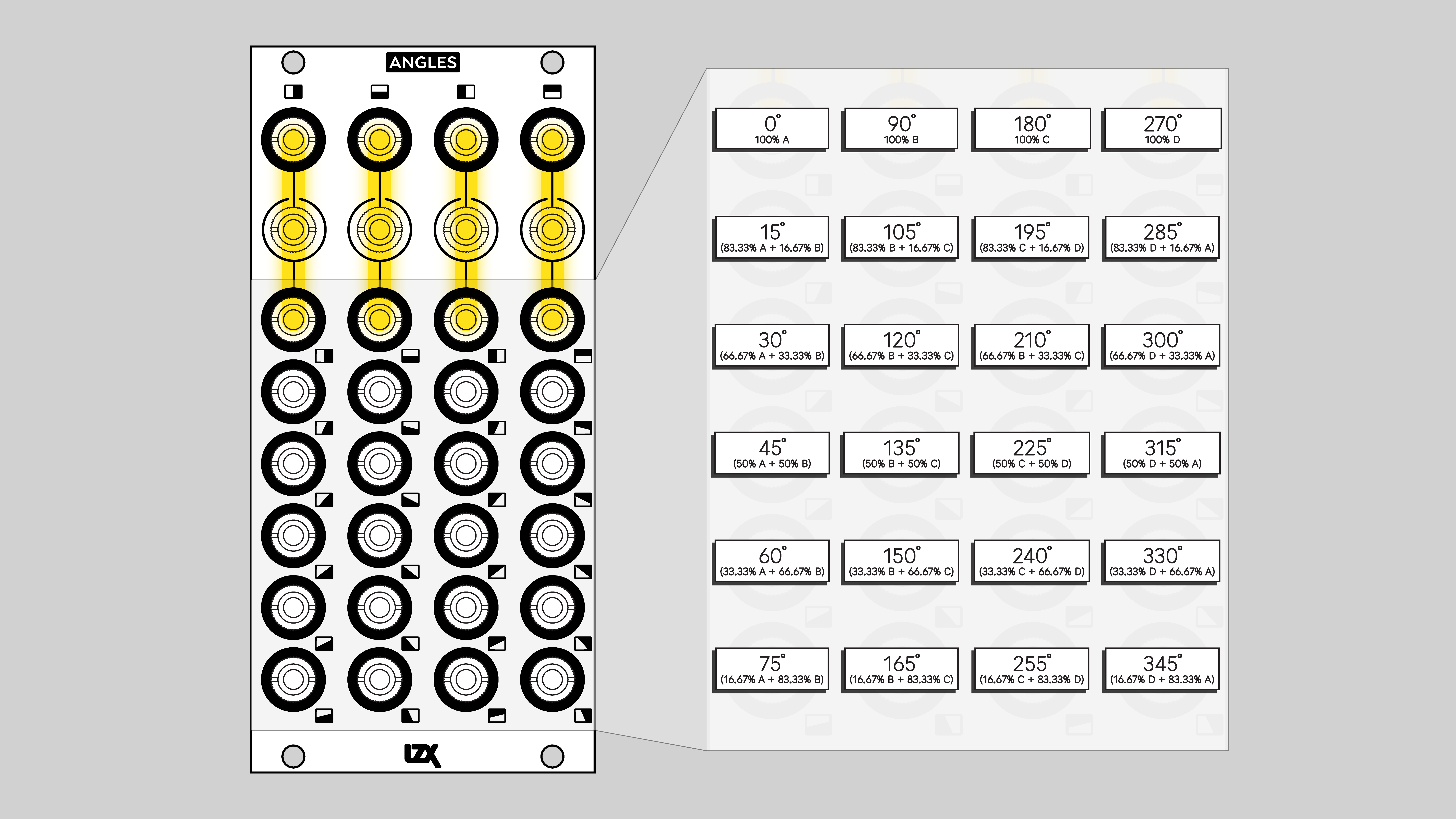
When two ramps are mixed, the result is an angled ramp. Different starting orientations and mixing amounts give different angles. ANGLES splits the circle in 24 equal sections, outputting 24 differently angled ramps, in rotational increments of 15 degrees.
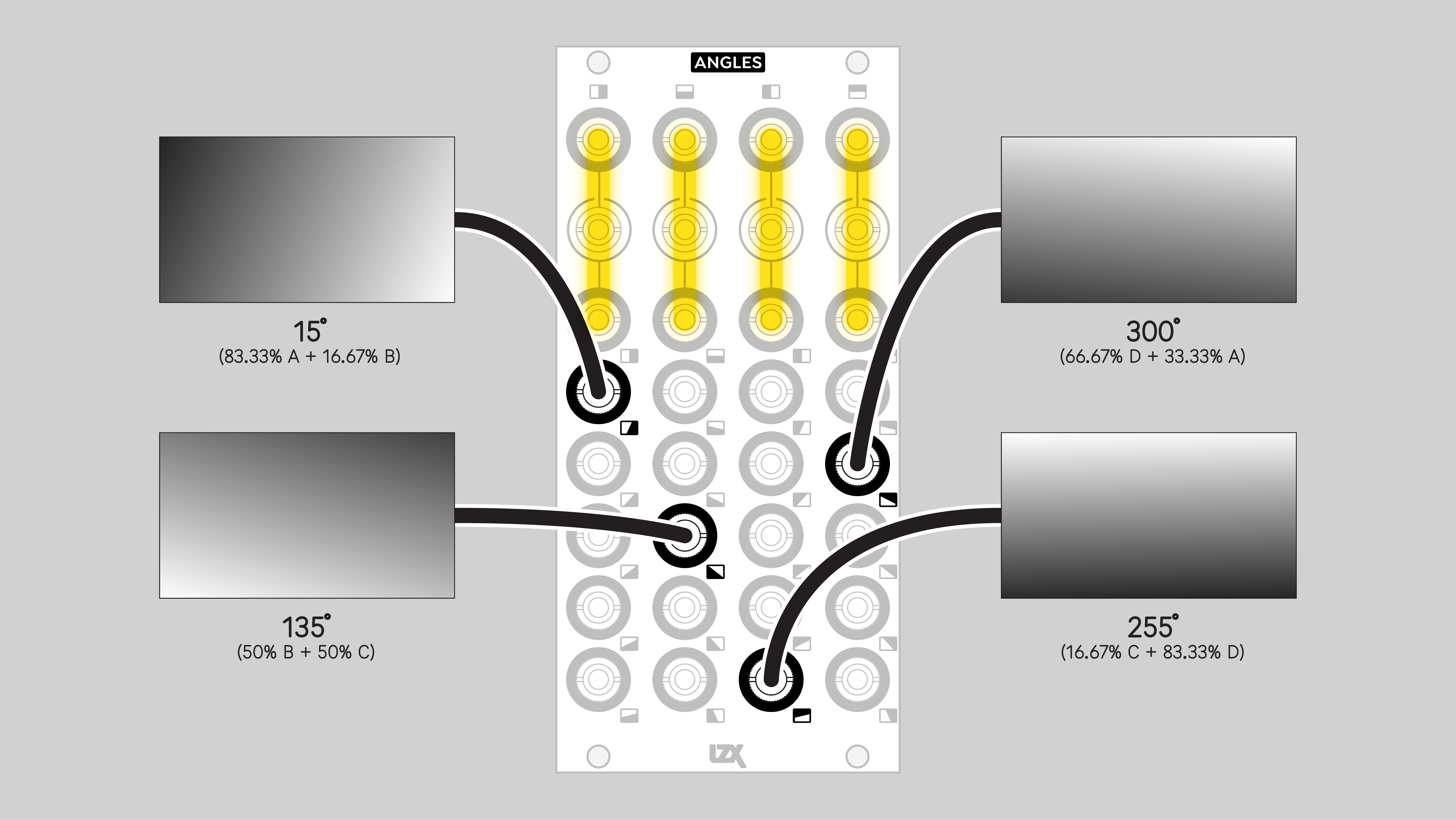
But ANGLES is not limited to its internal ramps. Any video or control signal can be mixed with any other signal. This opens up interesting possibilities, such as symmetrical mixes of two sources. For example, one mix of 66.&% A and 33.3% B, and a complementary mix of 33.3% A and 66.7% B.
Video Tutorial
3 Patches for Angles
presented by Johnny Woods
Example Patches
Waveshape Expander
Patch DWO3 or DSG3 outputs into ANGLES inputs to expand the available waveforms.
Spatial Reference
Patch any two outputs from ANGLES into DSG3 to completely change the orientation of its generated patterns.
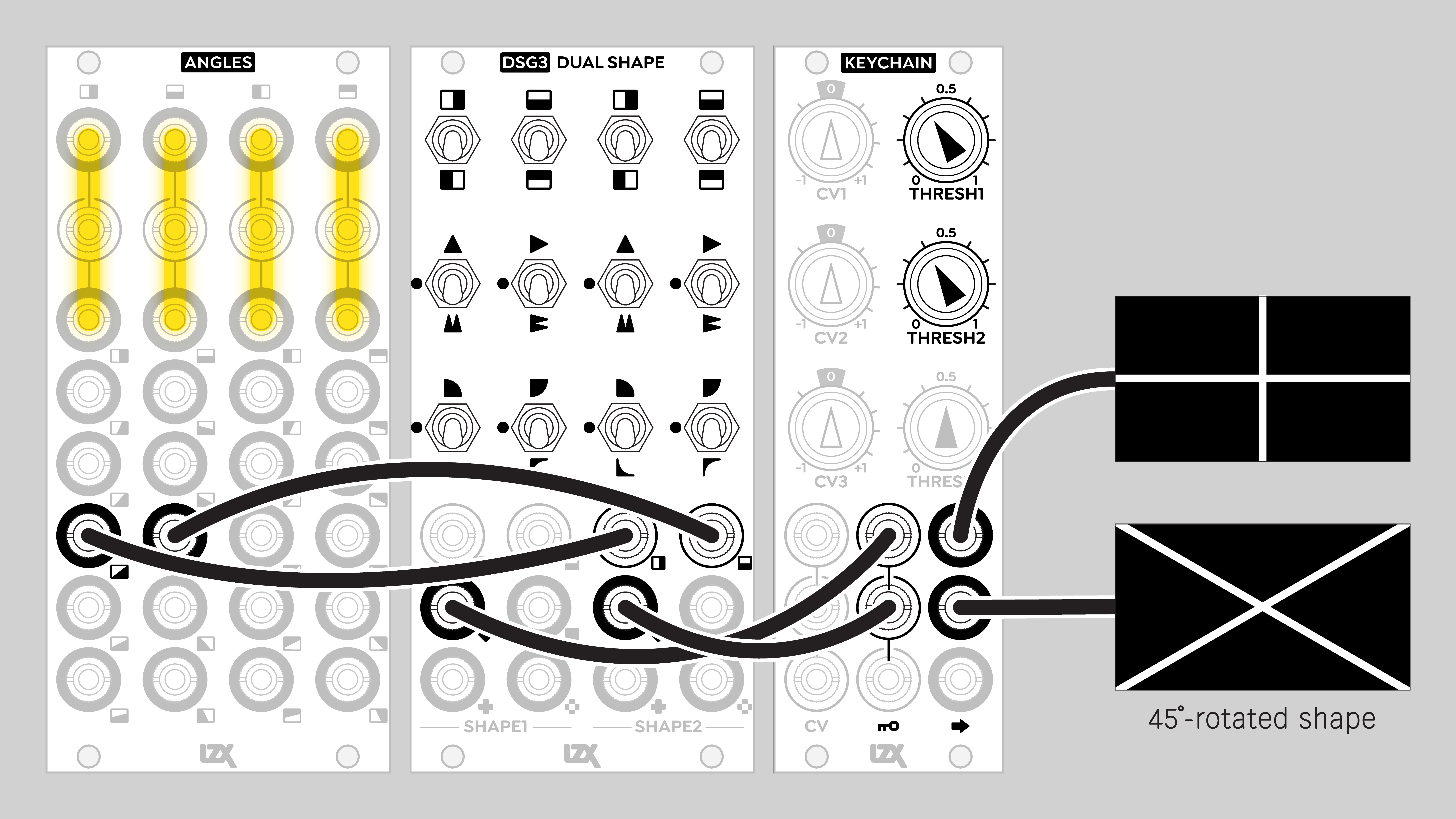
Complex Color Field
Use any three outputs from ANGLES as RGB channels to create a complex color gradient. This can be a direct visual element or a source of modulation.
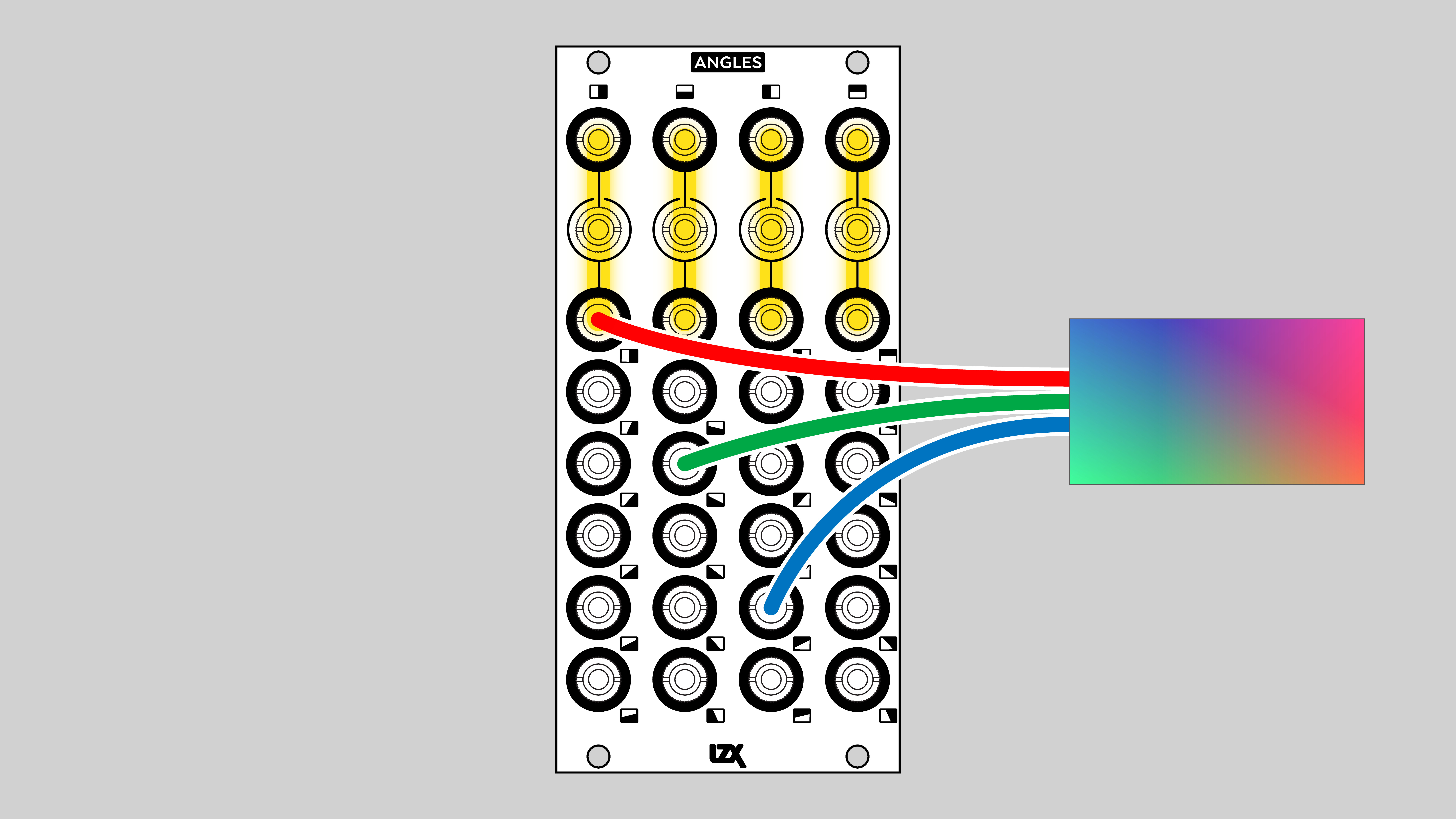
Quadrature Expander
Patch a quadrature oscillator into ANGLES' four inputs to create a full spread of 24 different output phases.
Hierarchical Spatial Reference
Patch any four outputs to the inputs of a second ANGLES module for a completely different set of 24 angles or mixer ratios.
Installation
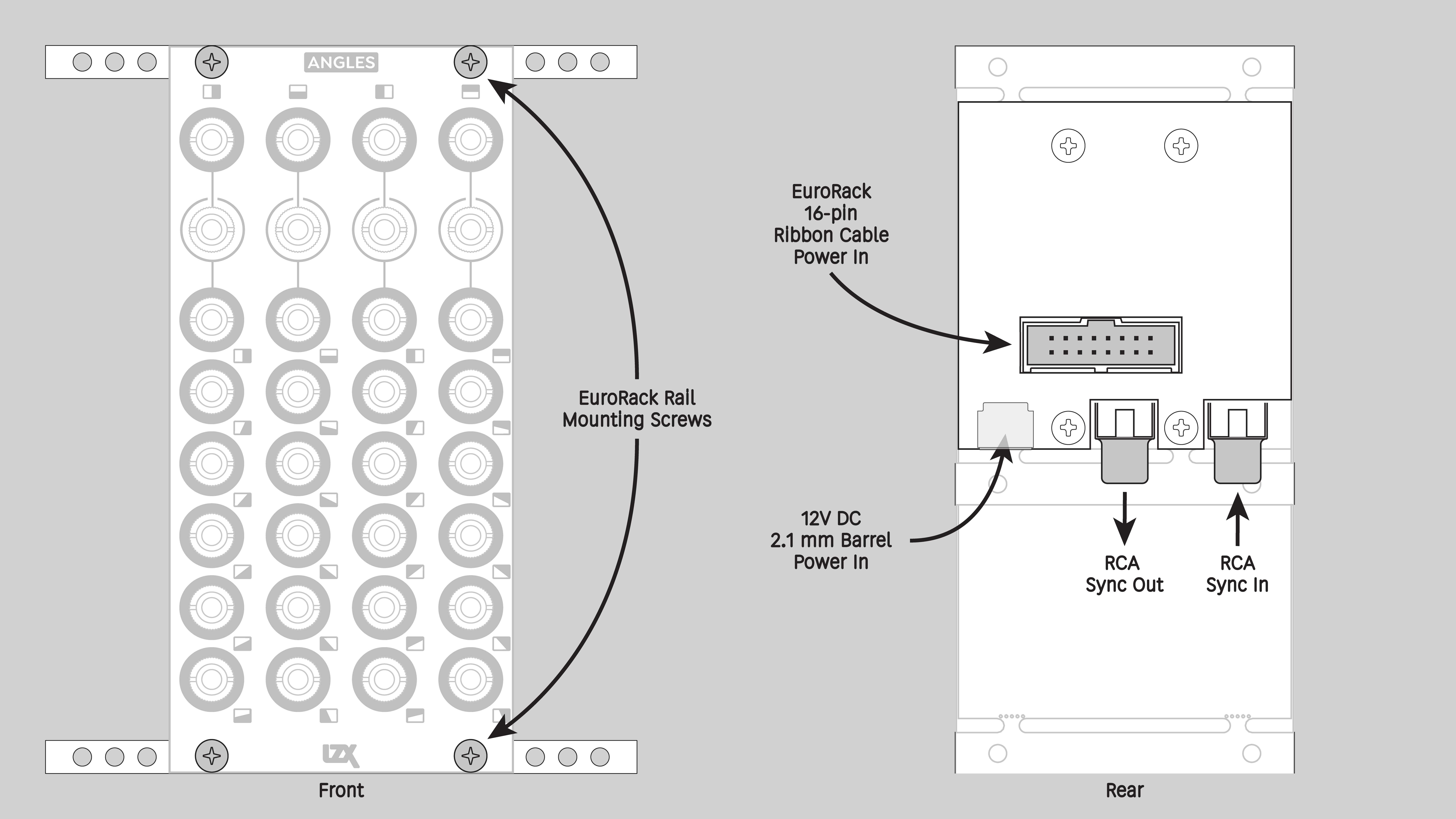
Requirements
- EuroRack enclosure.
- 12V DC or EuroRack power supply.
- 2.1mm DC barrel power cable or a EuroRack power cable.
- Four M2.5 x 6mm mounting screws, or screws provided or specified by the enclosure manufacturer.
- #1 Phillips head screwdriver, or hand tool provided or specified by the enclosure manufacturer.
Procedure
- Power off and disconnect the EuroRack enclosure's power supply and any attached DC adapters.
- Connect either the EuroRack Power Cable or the DC Barrel Power Cable to the module. Do not connect both Eurorack and DC Barrel power.
- Ensure that no mounting screws are in any holes in the area where you wish to mount the module.
- Carefully test fit the module with its attached power cable in the open space in the EuroRack enclosure. If it is obstructed by the enclosure or any internal assemblies, abort this procedure.
- Connect the disconnected end of the power cable to the power supply.
- Connect the sync cable to a sync source or the last module in the sync chain.
- Mount the module to the EuroRack rails using all mounting holes.
- Store the unused cable along with the product box in a safe location.
- Power on the EuroRack enclosure and start patching.
Full Specifications
| Front panel | Connectors | Connectors | ||||||||||||||||||||||||||||||||||||||||||||||||||||||||||||||||||||
|---|---|---|---|---|---|---|---|---|---|---|---|---|---|---|---|---|---|---|---|---|---|---|---|---|---|---|---|---|---|---|---|---|---|---|---|---|---|---|---|---|---|---|---|---|---|---|---|---|---|---|---|---|---|---|---|---|---|---|---|---|---|---|---|---|---|---|---|---|---|---|
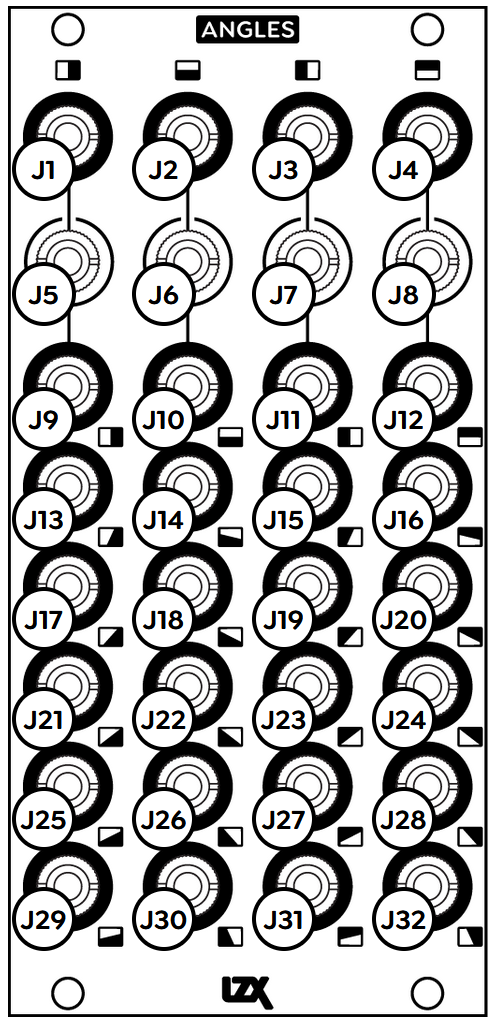 |
|
|
Technical Data
| Manufacturer Part Number | 950036 |
| Mounting Width | 12 HP |
| Mounting Depth | TODO mm |
| Mounting Hole Count | 4 |
| Power Consumption | 12V @ 175 mA |
| Power Connectors | 16 pin EuroRack ribbon, 2.1mm DC barrel |
| Input Impedance | 1M ohms |
| Output Impedance | 75 ohms |
| Input Protection Range | +/-20V |
| Input Clipping Range | +/-2.5V |
| Output Range | +/-2.5V |
| Included | DC barrel power cable, EuroRack power cable, RCA sync cable |
| EuroRack Power Cable Type | 16-pin |
| EuroRack Power Cable Length | 25 cm |
| DC Barrel Power Cable Length | 25 cm |
| RoHS Compliance | Manufactured with lead-free processes. |
| Video Sync | Rear RCA in & out |
Maintenance
Keep your module free of dust and debris by performing periodic cleaning. Spots may be cleaned from the frontpanel with a microfiber cloth and isopropyl alcohol or other electronics cleaner.
Hardware Revisions
The hardware revision code is printed on the circuit board visible from the rear of the module.